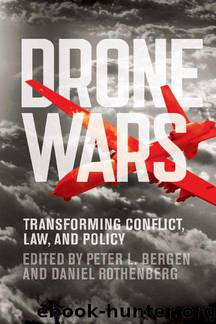Drone Wars: Transforming Conflict, Law, and Policy by Drone Wars; Transforming Conflict Law & Policy (2015)

Author:Drone Wars; Transforming Conflict, Law & Policy (2015)
Language: eng
Format: epub
Publisher: Cambridge University Press
Published: 2014-12-31T08:00:00+00:00
4. Legalizing Drones
There is nothing mystical about drones. They are neither inherently “evil” nor the answer to US national security concerns. Drone strikes are just another tactic in America’s lethal toolkit, simply another means of delivering death, not inherently any worse or any better than any other way of killing people.
From a narrow legal perspective, drones are also “business as usual.” Both the United States and the international community have long had rules governing armed conflicts and the use of force in national self-defense. These rules apply whether the lethal force involves knives, assault weapons, grenades, tank-mounted machine guns, or weaponized drones. When drone technologies are used in traditional armed conflicts – on “hot battlefields” such as those in Afghanistan, Iraq, or Libya, for instance – they pose no new legal challenges, and can and should be regulated using the existing laws of war.
But if drones used in traditional armed conflicts present no “new” legal issues, some of the activities and policies enabled and facilitated by drones pose enormous challenges to existing legal frameworks. For example, as discussed above, the availability of drone technologies makes it far easier for the United States to “expand the battlefield,” striking targets in places where it would be too dangerous or too politically controversial to send troops. Often this expansion challenges existing legal frameworks.
For example, drones enable the United States to strike targets inside foreign states, and to do so quickly, efficiently, and deniably.37 As a result, drones have become the tool of choice for so-called “targeted killing” – the deliberate targeting of an individual or group of individuals, whether known by name or targeted based on patterns of activity, inside the borders of a foreign country. It is when drones are used in targeted killings outside of recognized armed conflicts that their use challenges existing legal frameworks.
Law is almost always out of date: We make legal rules based on existing conditions and technologies, perhaps with a small nod in the direction of predicted future changes. As societies and technologies change, law increasingly becomes an exercise of jamming square pegs into round holes. Eventually, that process begins to do damage to existing law: it gets stretched out of shape, or broken. Ideally, we update the laws before too much damage is done. Right now, US drone policy is on the verge of doing irreparable damage to the rule of law – and it is not clear that either the president, Congress, or the public cares enough to address the issue.
Understanding how US drone policy challenges existing legal ideas, systems, and norms requires a consideration of the concept of “rule of law,” as well as a review of the relationship between the laws of war and “ordinary” law.
The rule of law – A lot of ink has been spilled defining the rule of law. At root, the concept is fairly simple. The rule of law requires that governments follow transparent, universally applicable, and clearly defined laws and procedures. The goals of the rule of law are to ensure predictability and stability and to prevent the arbitrary exercise of power.
Download
This site does not store any files on its server. We only index and link to content provided by other sites. Please contact the content providers to delete copyright contents if any and email us, we'll remove relevant links or contents immediately.
Steroids: History, Science, and Issues by Standora Joan E.; Bogomolnik Alex; Slugocki Malgorzata(1189)
A Practical Guide to International Arbitration in London by Hilary Heilbron(1077)
Adrift by Steven Callahan(1028)
Reclaiming History by Vincent Bugliosi(1017)
Persuasion by Owner(1008)
The Nuremberg Interviews by Leon Goldensohn(985)
Dog Company: A True Story of American Soldiers Abandoned by Their High Command by Lynn Vincent & Roger Hill(974)
40 Days and 40 Nights by Matthew Chapman(965)
Poisoned by Jeff Benedict(956)
Last Narco by Beith Malcolm(930)
The New Whistleblower's Handbook by Stephen Kohn(920)
Introduction to the study and practice of law in a nutshell by Kenney F. Hegland(893)
Kafka's Last Trial by Benjamin Balint(845)
Lincoln's Code by John Fabian Witt(839)
A Passing Fury by A. T. Williams(823)
Japanese War Crimes during World War II: Atrocity and the Psychology of Collective Violence by Frank Jacob(807)
Dog Company: A True Story of American Soldiers Abandoned by Their High Command by Roger Hill & Lynn Vincent(792)
Eichmann in Jerusalem by Hannah Arendt(791)
A Court of Refuge by Ginger Lerner-Wren & Rebecca A. Eckland(784)
